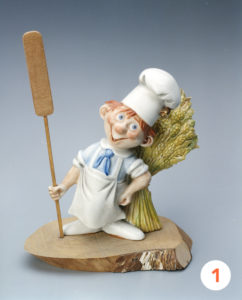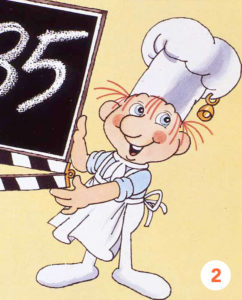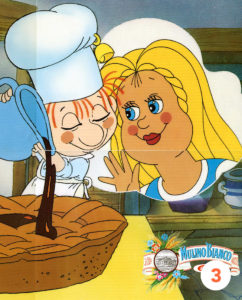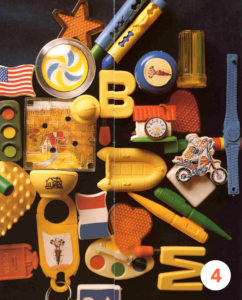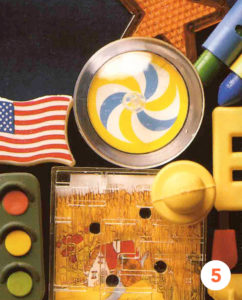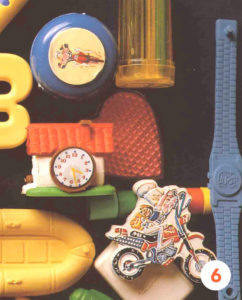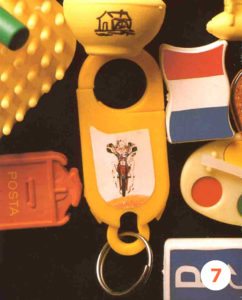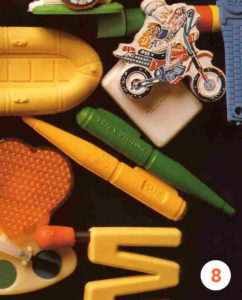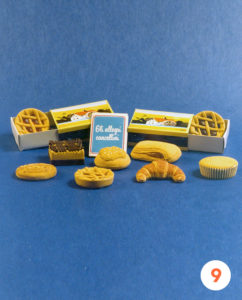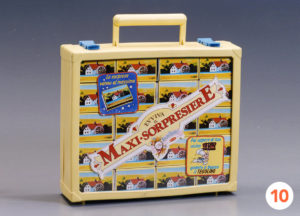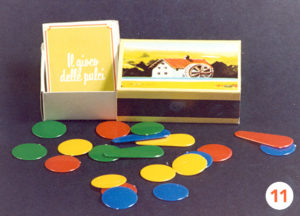The Little Surprises of Mulino Bianco (1983-1990)
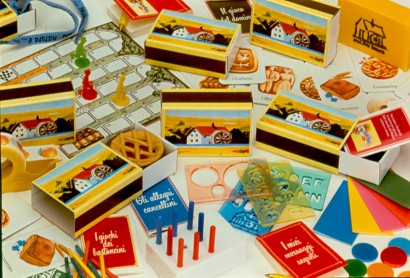
by Giancarlo Gonizzi
–Hello, I am Franca.
–Franca was the delightful young lady that answered the letters and messages that children all over Italy wrote to the Little White Miller (photos 1-2-3) –PMB for his friends – and that took care of in pack promotions, that is, those little gadget games inserted into small cardboard boxes like those used for matches. These were found inside Mulino Bianco packages of snacks up until 1990.
– We are relocating our offices. I would like to send you a few boxes of Mulino Bianco Little Surprises. Would you like to have them for your Archives? – In reality, “a few boxes” meant an entire truckload of boxes that in a matter of a few days submerged the deposits of the Historical Archives. The boxes contained other boxes made of white cardboard, thin and narrow, and these, in turn contained the small boxes filled with Little Surprises.
A hellish Matryoshka with hundreds of types and models (photos 4-5-6-7-8). A folly even for the best intentioned of archivists.
–Franca, it is impossible for me to manage this. We would need a map, a list, a chronology…
–Ah! But if it’s just that, I have already made a chronology! There is a bit of confusion with numbers, some double entries, but you can reconstruct the subdivision into years: it was the hand written list of orders that were sent to the Purchasing Offices.
We numbered the entire series anew, using the descriptions given by Franca, and with that list it was possible to “line up” 560 Little Surprises, all different from one another. These were designed, made and distributed in the span of seven years. An outstanding patrimony of creativity and brand identity that had to be absolutely preserved. Yes, but how?
For every specimen, there could exist one sample as well as ten or twenty… Aside from some “out of size” objects, almost the total fell into the matchbox size items. The idea to use a drawing cabinet to keep the Little Surprises came up.
The Purchasing Office ordered some special acetate plastic boxes with a small lid that fit perfectly into the drawers to be made for us. Thus, we created rows of 12×6 objects for each drawer, and all of them were “visible” since they were contained in transparent boxes.
As a rule, we decided to keep three pieces of each subject and to insert the variants (of color and shape) into the same box (photos 9-10).
In a couple of months, we were able to “connect” each of the Little Surprises to their various descriptions, and to give each a year of production and a progressive number. The cabinet became progressively populated with colored gadgets in various shapes. Franca came to our rescue when an object or its description became particularly difficult to connect. In the end, an entire cabinet hosted the collection: an amazing sight, but at that time, it was not possible to do more.
Graziella– the mother of all of the Little Surprises – the one who thought of them and designed them for years, helped us to put in order some of the collections, thanks to her contacts with the various manufacturers.
Years later, a “Work School Program” made it possible for us to complete the operation. Our Priceless helper Giampaolo taught an accelerated course in professional photography to the students of the Lyceum of Sciences that in a month photographed all of the objects – with their related variants – and inserted digital photos and Meta data – names, measures, dates, manufacturer… – in an electronic sheet (photo 11).
Roberto, on his part, with laudable patience, in one month loaded the entire material on the computer system and… we realized there where holes! Since in the bustling work of the office a few objects had not been stored or went lost who knows where, about thirty Little Surprised were missing. The web and the amazing Rosy, a passionate collector – and a good dose of patience – helped us to find and retrieve the missing subjects. Today, the web site of Barilla Historical Archives makes it possible to consult on-line the entire series of Little Surprises. I like to think that an archive is a collective work, especially in a case like this.
